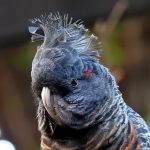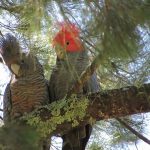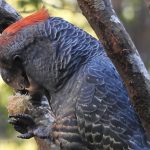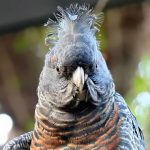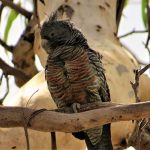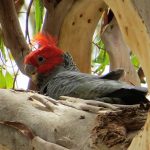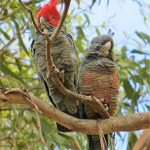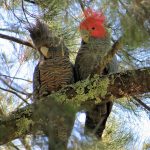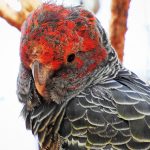GANG-GANG COCKATOO
The Gang-gang Cockatoo is a unique and visually striking species of cockatoo native to Australia. It is known for its distinctive appearance and calls.
The male Gang-gang Cockatoo has a striking appearance with a dark grey body and head, complemented by a bright red head crest. The crest is fringed with fine feathers, giving it a “fringed” appearance, which is where the bird gets its name from. Females have a similar coloration but with less vibrant colours.
The Gang-gang Cockatoo is endemic to south-eastern Australia. It is typically found in cool, temperate forested regions, including mountain ranges and wooded areas.
These cockatoos primarily feed on seeds, particularly from native eucalyptus trees. They are also known to consume berries and other plant materials.
Gang-gang Cockatoos are relatively quiet compared to other cockatoo species, and their calls are more subdued. Their distinct call is a soft, high-pitched “creaky gate” sound, which is often likened to a creaking door.
During the breeding season, which is usually in spring and summer, Gang-gang Cockatoos form monogamous pairs. They build nests in tree hollows and lay clutches of 2 to 4 eggs. Both parents participate in incubating the eggs and caring for the chicks.
Loss of older, hollow trees and loss of feeding habitat across south-eastern Australia through land clearing has led to a significant reduction in the numbers of this cockatoo in recent years. As a result, the gang-gang is now listed as vulnerable in New South Wales. It is protected as a vulnerable species under the Biodiversity Conservation Act 2016 (NSW).
The Gang-gang Cockatoo is considered an iconic bird in some parts of Australia and is often featured in indigenous artwork and folklore.
These beautiful cockatoos are admired by birdwatchers and nature enthusiasts for their unique appearance and their presence in Australia’s diverse avian fauna. As with any wildlife, it’s essential to appreciate and observe them responsibly in their natural habitat while ensuring their conservation and protection for future generations to enjoy.

